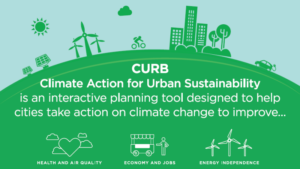
During Climate Week NYC in September 2016, the World Bank, together with C40 Cities, the Compact of Mayors, and other partners, launched a new planning tool called “CURB: Climate Action for Urban Sustainability,” which can help address some of these issues.
CURB provides tailored analyses that can help city officials more easily identify, prioritize, and plan cost-effective and efficient ways to reduce carbon emissions,” said Stephen Hammer, Manager of Climate Policy at the World Bank, who led CURB’s development.
The CURB tool relies on city-specific data to estimate the cost, feasibility, and impact of a range of climate actions under different scenarios. Using CURB, city officials can:
- Explore an array of climate-smart options—from more efficient transport systems to retrofitted buildings;
- Define what goals are realistic;
- Simulate technology and policy changes to assess the best course of action; and
- Analyze project financials to determine cost-savings and returns on investment.
Planning climate action in 5 steps
- Setup is where you enter basic data about the overall situation in your city and specific sectoral profiles. This information is then used repeatedly throughout CURB to help make different calculations.
- Inventory converts the information provided in the Setup module into estimates of which sectors create the greatest energy demand and GHG emissions and how this situation may change over time. You also have the option to set future reduction performance targets against which progress can be measured.
- Context allows you to understand the drivers of emissions and energy demand in your city. You can also compare your city with other cities across a range of key performance indicators.
- Actions is the heart of the tool. This module allows you to select which sectors you would like to target based on: a) your city’s authority to take action in each sector and b) a rapid assessment of the maximum impact potential and implementation feasibility of every intervention in CURB. This is intended to help users decide which interventions are worthy of further exploration. Users are then given the opportunity to craft a scenario, customizing and bundling different interventions into a comprehensive plan. Detailed cost and impact assessments are calculated based on information you provide about the anticipated deployment level of each intervention. At any time, you may go back and change the options which you have selected, either to drop or add interventions or to change the anticipated deployment rate that will ultimately be achieved.
- Results shows you the combined impact of your selected interventions on urban GHG emissions, local energy demand, and spending levels. In this module, you will also see how successful different scenarios are in delivering your emission or energy demand reduction targets.
How and where is CURB being used?
CURB is being used by cities globally in a number of ways including for the following purposes:
- Developing city climate action plans
- Evaluating vendor bid proposals to assess the most cost-effective and environmentally friendly plans
- Prioritizing investments within a particular sector or across multiple sectors
- Understanding realistic energy-use or emissions targets for the city
- Creating and optimizing plans based on cost constraints, energy-use objectives, or emissions targets